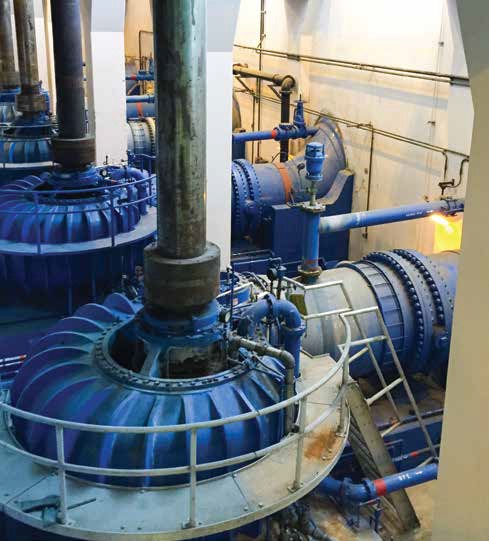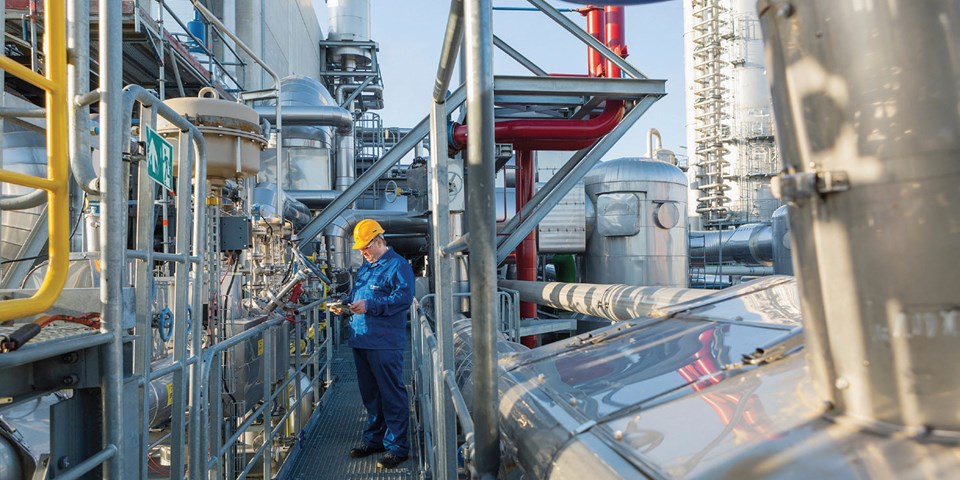By Lucien Joppen
Valve World visited Dijkman at the oldest Verbund-site of BASF in Ludwigshafen. In the enormous complex, it takes roughly 20 minutes by car – the maximum speed is 30 km/h – to the Service Center where Dijkman’s office is located. He heads the Global Service Center for Automated Valves at the German chemical powerhouse.
Dijkman has been active in instrumentation in general and later on more specifically in automated valves. When asked what attracts him in this domain, he mentions complexity. “No configuration (valve, actuator, instrumentation) is the same. This complexity also leads to vulnerability of the production process. As BASF’s Service Center for automated valves, it’s a challenge for us to improve these devices and harmonize where we can. Naturally, the Service Center is heavily involved in servicing/repair and (re-)assembly of the valves that are installed in Ludwigshafen. Advising our business units is also part of our job. For example, which valve/actuator configuration is needed for a certain application or a recommendation to use adapted pieces if needed.”
Not an Easy Configuration
Dijkman mentions harmonization as a way to make things more straightforward in the production environment of the chemical industry. This is why BASF is a member of Namur and participates in standardization committees, where various companies active in the same sector bundle efforts and work on non-competitive issues.
“Within Namur, we work closely with suppliers to devise common standards that serve all stakeholders to improve our processes and to make everybody’s life easier and safer,” Dijkman says, and he picks up a pneumatic control valve. “At first sight, I wouldn’t call this a bad valve. The standard configuration always has a positioner on the side, and if the valve has a safety function, also a solenoid is fitted for safe shutoff. You can also see pneumatic tubes at various angles. These tubes can be made from plastic or stainless steel, depending on the application. Whatever the material is, the configuration is not easy to decipher. I am proficient in the area of valve pneumatics, yet it takes some time for me to see which tubes are meant for which function.”

Difficult
According to Dijkman, the somewhat complex configuration leaves room for errors in the areas of installation and maintenance. Fortunately, such mistakes do not happen frequently, Dijkman says, but when they occur, they can lead to production loss, partial or even total shutdowns. Problems can also arise when certain parts/accessories need to be replaced. “We use accessories for our valves from various suppliers. Some of these accessories become obsolete; accessories may not be available at certain times and what if we need to exchange positioners and the new one happens to have its connections at different points compared to the old one? In case of plastic tubes, it is not so much a big deal, but with stainless steel tubes, it becomes increasingly difficult. There are also potential issues with connecting the tubes which, if for example not fully inserted in the fitting, can become loose once pressurized and force a valve in its safe position.
A New Standard for BASF
The idea for the IPM started before Dijkman joined the Service Center. When asked how the IPM came to fruition, he says the Service Center has been the key driving force. “Our service people deal with these valve/actuator configurations and experience at first-hand the complexity of these systems. At one point, the question arises: ‘how can we improve this?’ It took at least a couple of years to develop and test the IPM and take our colleagues along from other companies, both end-users and supplies, in the necessary standardization effort in the Namur- and VDI/VDE-committees. Within BASF Ludwigshafen and an increasing number of other BASF sites, I can say that the IPM has become the standard and the conventional set-up the outdated version. Of course, there are still thousands of ‘old’ configurations in our assets worldwide. Gradually, these will be replaced by IPMs.”
One-Size-Fits-All
What looks at first sight as a simple aluminium block holds a range of functionalities which are realized through a maze of cleverly arranged air channels and standardized interfaces. Its main function is to simplify and harmonize the way pneumatics are connected around the actuator, Dijkman says. “It is a one-size-fits-all solution which is suited for our standard suppliers. Naturally, we have involved these suppliers in the design of the IPM to facilitate a seamless implementation in our supply chain. It wouldn’t make sense to force a design which would make it difficult for our suppliers to adapt to. As you might expect, valve/actuation manufacturers have different designs for internal pneumatic connections which in turn makes it difficult to harmonize. With the IPM, we are less dependent on these individual configurations. It also makes it easier to choose between various solutions as long as they are compatible with the IPM.”

Fast and Uncomplicated
So the IPM increases BASF’s flexibility in terms of its supply base. It also decreases the complexity by reducing the number of variations in the installation process. This exercise not only lowers the cost of storing individual components, but it also saves time in installing or retrofitting, Dijkman says. “For example, some valves might need a solenoid later in their life cycle when a safety function is added. In the conventional configuration, this would be quite an operation as you would have to redo all the tubing again. With the IPM, you only have to take a small plate off and then screw the solenoid on the interface (E, see next page), and basically, you are done. That’s also the time that it takes to exchange an accessory. It is fast, it is uncomplicated, it doesn’t require a technician who knows the proper way to bend tubes, and it is foolproof. It is a plug-and-play solution which saves time and minimizes potential errors.
Gradual Introduction
The IPM has been in operation since 2017 in the Verbund-site in Ludwigshafen and on other Verbund-sites in the world. “Gradually, we are introducing the IPM into our organization,” Dijkman says. “Typically, we advise to retrofit when valves require more servicing than the usual and still have a significant part of their life-cycle ahead of them. Its use is growing although I can’t disclose actual numbers.”
Asked about applicability to valves without an integrated air supply through the yoke, Dijkman answers: “The IPM can in principle be mounted to any valve. What you could do is to mount it to this ‘Namur-rib’ (a standardized mounting position at the yoke), after which you would only have to add the tubing to the air chamber.”
Larger Diameter Tubing
A current ‘limitation’ of the IPM is that is designed/defined for tubing up to a quarter-inch, which for BASF covers some 90 per cent of all valves. According to Dijkman, the IPM concept could be extended in this aspect. “There is the issue of larger diameter tubing and the ability to also mount a booster in a modular way without the tubing. We work closely with suppliers to adapt the IPM to tubing up to an inch. We have to make our wishes known, and they also have to make sure that the interface can accommodate the functionality and dimensions of their devices. This is ongoing work in the VDI/VDE and within Namur. We are making good progress in this matter, and I expect that in 2020 the standard can also cover devices up to 1 inch.”
Valve World
As for the existing IPM, several manufacturers produce the interface device. It has been on display at the last Achema – in 2018 – and on the Valve World Expo in the same year. More end-users have adopted the IPM, Dijkman says, which means market demand is stepping up for the device. As Dijkman stresses, the IPM can also be used in other industry sectors. “We have tested the device also under harsh conditions for more than six months. These tests yielded positive results, and the IPM has been included in guidelines according to VDI/VDE 3845, 3847 and Namur NE019. All of our actuator suppliers can work with these requirements, which is important if we are to roll out the IPM in greater numbers.”


